Caribbean Sea Offshore Wind Energy Assessment and Forecasting
Brandon J. Bethel
Abstract The exploitation of wind energy is rapidly evolving and is manifested in the ever-expanding global network of offshore wind energy farms. For the Small Island Developing States of the Caribbean Sea (CS), harnessing this mature technology is an important first step in the transition away from fossil fuels. This paper uses buoy and satellite observations of surface wind speed in the CS to estimate wind energy resources over the 2009-2019 11-year period and initiates hour-ahead forecasting using the long short-term memory (LSTM) network. Observations of wind power density (WPD) at the 100-m height showed a mean of approximately 1000 W/m2 in the Colombia Basin, though this value decreases radially to 600-800 W/m2 in the central CS to a minimum of approximately 250 W/m2 at its borders in the Venezuela Basin. The Caribbean Low-Level Jet (CLLJ) is also responsible for the waxing and waning of surface wind speed and as such, resource stability, though stable as estimated through monthly and seasonal coefficients of variation, is naturally governed by CLLJ activity. Using a commercially available offshore wind turbine, wind energy generation at four locations in the CS is estimated. Electricity production is greatest and most stable in the central CS than at either its eastern or western borders. Wind speed forecasts are also found to be more accurate at this location, and though technology currently restricts offshore wind turbines to shallow water, outward migration to and colonization of deeper water is an attractive option for energy exploitation.
Keywords Offshore wind energy · Wind energy forecasting · Caribbean Sea · Long short-term memory network · Offshore wind turbines
1 Introduction
Pressured by anthropogenic climate change, renewable energy has over the past few decades, rapidly advanced, and wind energy stands as one of the most mature alongside solar energy. Having successfully colonized the land, wind turbines are being installed further and further offshore.While offshore wind turbines are more expensive to construct and maintain than their onshore counterparts (Díaz et al., 2016; Satir et al., 2017; Hevia-Koch and Jacobsen,2019), they are advantaged in that over the ocean, energy availability is significantly larger due to a greater downward transport of kinetic energy from the overlying atmosphere,allowing power generation in some ocean areas to exceed land-based power generation by a factor of three or more(Liu et al., 2016; Possner and Caldeira, 2017). To initiate offshore wind energy projects, a resource assessment is a crucial preliminary step and is carried out in a variety of ways that include but are not limited to numerical weather prediction models, in situ and remotely sensed observations.
Due to the expense of installing and maintaining large buoy networks, in addition to the large spatial distances in between each buoy, literature detailing direct wind resource assessments using buoy observations is sparse. Nonetheless,Leahy et al. (2012) assessed the viability of using offshore meteorological buoys in assessing wind energy resources in the Atlantic Ocean and the Irish Sea and concluded that although due to assumptions and errors related to buoy wind data accuracy the wind energy assessment would be imperfect, buoys can still be used. Bagiorgas et al. (2012) accessed ten buoys throughout the Aegean and Ionian Seas to assess wind speed and wind power characteristics and found that two sites could be classified by wind classes 6 and 7. It was also observed that 15%-16% higher winds were observed at the 10-m height as compared to 3 m. Additionally, it was calculated that wind turbines at these sites could produce energy for more than 70% of the time. Chen et al. (2017)used six buoys located along the Shenzhen coast to assess both wind and wave energy resources and concluded that while wind energy was, for the region, plentiful at 37-94 W/m2, wave energy was negligible. With the advent and validation of several buoys specifically developed for wind resource assessments (García et al., 2018; Gorton et al.,2019; Viselli et al., 2019; Yu et al., 2020), additional studies will undoubtedly be conducted. However, a wide range of other methods are currently available to estimate and forecast wind energy resources and this includes usage of satellite observations.
Guo et al. (2018) assessed the global wind energy resources using a wide array of satellites and compared the results with National Data Buoy Center (NDBC) buoys at 10-m and 100-m heights. Using multiple satellites, the authors found a more reliable estimation of wind energy resources. Wang et al. (2019) assessed the applicability of a variety of surface wind datasets inclusive of satellite-based observations, reanalysis, in addition to regional atmospheric models, and found that the best overall performance came from QuikSCAT and ASCAT in terms of bias when compared with central Californian coast buoys. Remmers et al.(2019) assessed the ASCAT satellite platform’s ability to characterize the spatiotemporal offshore wind information for offshore renewable energy infrastructure and found it could reliably represent in situ measurements in Irish waters and assist in the offshore wind farm site selection process.Zaman et al. (2019) assessed the offshore wind energy resources in Malaysia using multi-mission satellite altimetry data and found that the density of wind power increased with increasing distance from the Malaysian shorelines. The authors also suggested that combining satellite altimetry,in situ observations and numerical modeling enhance off-shore wind energy resource assessments. Carvalho et al.(2017) combined satellite, a numerical model, and buoys to characterize offshore winds and wind energy production for the Iberian Peninsula Atlantic coast. It was suggested that ASCAT provided the lowest wind speed temporal variability and wind power flux estimation errors, with WRF providing the best alternative to that product. Soukissian et al. (2017)used the Blended Sea Winds product and found that the eastern Mediterranean Sea has a high annual wind speed with moderately low temporal variability. There, the mean annual wind power density was measured at approximately 1600 W/m2and 1500 W/m2in the Gulf of Lions and the Aegean Sea, respectively. Pereira and Silva (2020) combined satellite data observations and the Weather Research and Forecasting (WRF) atmospheric model to assess the offshore wind energy resource in Porto Santo Island and found that in comparisons with observations, WRF was shown to be proficient at simulations of wind speed and direction.
With the rise of big data, soft computing and artificial intelligence methods, the forecast of wind energy resources,particularly on short timescales is especially useful for off-shore wind power scheduling and operation control. Zheng et al. (2018) used a deep neural network to extract deep data characteristics to improve the forecasting model efficiency.As compared to the back propagation (BP) and wavelet neural networks, the deep neural network outperformed both by more than 40%. Long short-term memory (LSTM) networks were also used to perform wind speed forecasting. Shi et al.(2019) compared LSTM to other conventional BP, extreme learning machines, and support vector machine (SVM) models, and found that LSTM had much lower error values and could be used to forecast wind speed at adjacent turbines.Li et al. used LSTM for ultra-short-term wind power forecasting in a Western China wind farm and found that the model, when Spearman rank correlation was used to identify LSTM hyper-parameters, outperformed traditional artificial neural networks. For short-time wind speed forecasts,Ibrahim et al. (2019) compared four neural network-based algorithms: artificial neural networks, convolutional neural networks, LSTM, and a hybrid convolutional LSTM (convLSTM) network and one SVM model and found that while SVM was most accurate, convLTSM was less computationally expensive and still provided high prediction accuracy.
Within the Caribbean Sea, Rueda-Bayona et al. (2019a)conducted a literature review of international actions geared towards encouraging different countries to establish strategies to reduce CO2emissions, in addition to advances and challenges in implementing offshore wind technology, and the administrative framework of renewable energy in Colombia. There, it was demonstrated through the usage of satellite data, it was identified that a previously reported wind power density of 1700 W/m2was significantly higher than the observed values at La Guajira (482 W/m2at 110.8 m), Barranquilla (857 W/m2at 323.2 m), and Santa Marta (658 W/m2at 10 m). A dataset of wind speed and wind power density at four locations in Colombia accompanied the study (Rueda-Bayona et al.,2019b). Chadee and Clarke (2014) characterized the wind energy potential of the Caribbean using 31 years of the near-surface reanalysis dataset and found that the regional area-averaged wind speed attains a primary maximum in January and a secondary maximum in July. Moreover, it was identified that under the influence of the Caribbean Low-Level Jet (CLLJ), wind power density was measured at 300-400 W/m2. Chadee et al. (2017) attempted to find the optimum configuration for WRF to map the near-surface wind energy resources in Trinidad and Tobago. A subsequent technical and economic assessment of windgenerated electricity was conducted by Chadee and Clarke(2018) for the same country found that the usage of large contemporary wind turbines would be cost-competitive for Caribbean small island developing states (SIDS). Rogers et al. (2019), though studying onshore wind energy,predicted a favorable levelized cost of electricity. With the accelerating global transition to renewable energy and at the precipice of the United Nations (UN) Decade of Ocean Science for Sustainable Development (2021-2030),investigating the offshore wind energy in a Caribbean Sea bordered by SIDS is an extremely relevant research topic,especially given the projections of increasing annual wind speeds (Costoya et al., 2019). For the Caribbean Sea that has significant potential to harness ocean renewable energy, understanding the spatiotemporal distribution of wind energy is also essential towards achieving the UN Sustainable Development Goals (SDGs; UN, 2019).Specifically, this paper seeks to contribute to the research that undergirds SDG 7 which concerns affordable, reliable,sustainable, and modern energy for all. Consequently, the rest of the paper is structured as follows: Sect. 2 describes the data and methodology. Section 3 contains the results which are bisected into the wind energy assessment and forecasting subsections. Section 4 presents the conclusion and a discussion.
2 Data and Methodology
2.1 Data
A total of four buoys owned and maintained by the National Buoy Data Center (NDBC) are accessed for their surface wind speed observations in the area enclosed by 8°N-20°N and 60°W-90°W (Figure 1, Table 1). This data ranged from 2009 to 2019 and possesses an hourly resolution. Extensive data curation was done to eliminate invalid entries and characterize the volume of missing data to ensure that analyses were representative of the full 11-year period. Relevant buoy statistics are provided in Tables 1 and 2.

Table 1 Accessed National Buoy Data Center buoys and their relevant statistics

Table 2 Accessed National Buoy Data Center buoys and their relevant statistics continued
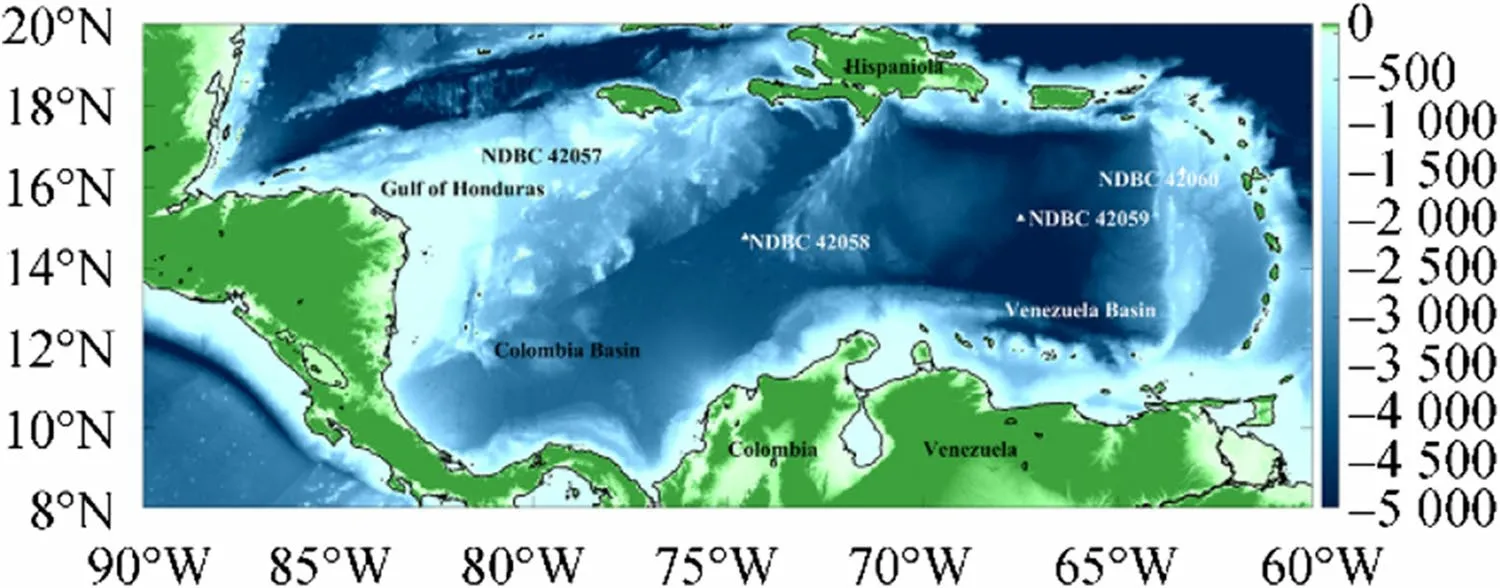
Figure 1 Study area with National Data Buoy Center buoy locations marked. Shading is the water depth (m)
Using Eq. (1), wind speeds were converted to the 100 m height using the simplified log-law equation:

where U(z) is the wind speed at height z, z0is the roughness length (0.01), and zRis a reference height. Although the roughness length for open sea conditions is much smaller(0.0002), early studies by Frank et al. (2000) and Barthelmie(2001) suggest that provided wind speed being vertically extrapolated is greater than 10 m above sea level, any variation in the roughness length of the sea surface is too small to have a significant impact on average wind resources at typical turbine hub heights (Barthelmie et al., 2007). This value is also used widely in other studies (e.g., Ma et al.,2021) and will be used here to maintain consistency.
In addition to in situ buoy observations of wind speed,ASCAT scatterometer-observed wind speed, and direction are also acquired on a spatial resolution of 0.25°×0.25° and ranges 8°N-20°N and 60°W-90°W. Temporally, the data ranges from January 1, 2009, to December 31, 2019, and is on a daily resolution. Data is downloaded via the OPeNDAP Server maintained by the Asia-Pacific Data-Research Center.
2.2 Methodology
2.2.1 Wind Energy Estimation
Given a sufficiently long time series of wind speed data for a given region, the wind power densityPper unit areaAis given by:

wherevis the wind speed (m/s) andρis the air density(1.025 kg/m3). Following the estimation of wind energy resources, how the resources vary on interannual scales is also crucial in identifying optimum locations for energy exploitation. Consequently, the dimensionless coefficient of variation index is used to estimate this interannual variability on monthly (3) and seasonal (4) scales (Rusu et al., 2018):
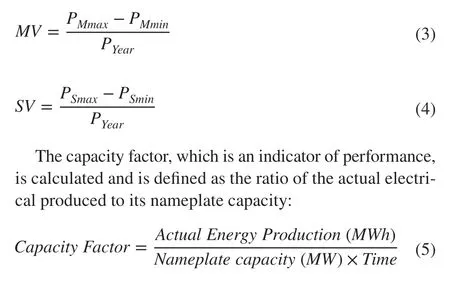
The corresponding output function for a wind turbine is defined as follows (Sohoni et al., 2016):

To simulate the total theoretical power generation at each buoy location, this paper selects the Swiss Electric YZ150/10.2 offshore wind turbine. Statistics concerning the rated power, cut-in, rated, cut-out, and survival wind speeds are listed in Table 3.

Table 3 Swiss Electric YZ150/10.2 turbine power curve coefficients
2.2.2 The Long Short-term Memory Network
Following the wind energy assessment, wind speed forecasts are performed for each location using available buoy observations converted to the 100-m height. For grid stability and reliability considerations, in addition to the optimization of market design, proper maintenance/operations, and power scheduling, frequency response reserves etc., forecasting wind power generation is crucial (Lledó et al., 2019; Al-Dahidi et al., 2020).
Although a variety of methods exist for wind speed forecasts and include numerical weather prediction models such as WRF, statistical methods, spatial correlation models,artificial intelligence, or hybrid methods (Han et al., 2015;Chang, 2014), an artificial intelligence method, the long short-term memory (LSTM) network, is employed due to low computational expense and its high degree of accuracy(Gangwar et al., 2019; Ibrahim et al., 2020; Marndi et al.,2020). The LSTM network (Figure 2) is a type of recurrent neural network that is widely used for complex time series analyses, machine translation, speech recognition and as relevant for this paper, wind speed predictions (Gökgöz and Filiz, 2018; Zhang et al., 2019; Banik et al., 2020) because it overcomes the well-known vanishing gradient problem as it employs a function whose second derivative can persistfor a long while before reducing to zero. One of the benefits of using deep learning methods is that though relationships between nonlinear data may be hidden, they can still be extracted, and predictions performed. Through a series of forget (ft), input (it), and output (ot) gates, patterns in long sequences of data can be selectively conserved and this process gives the network an advantage over conventional feed-forward neural networks and other RNNs. Information to be forgotten is identified by passing data (ht-1andxt)through a sigmoid function that ranges from 0 to 1, so that if the output is 0, information is forgotten, and if 1, information is retained. Conserved information is saved in the input gate and the sigmoid function is applied to the results before further processing with the tanh function and Hadamard product operator (ʘ; Yu et al., 2019). The strength and direction of current information storage (it) ranges from 0 to 1, andctranges from-1 to 1. Each gate is computed as follows:

Figure 2 Block diagram of the long short-term memory recurrent neural network cell unit
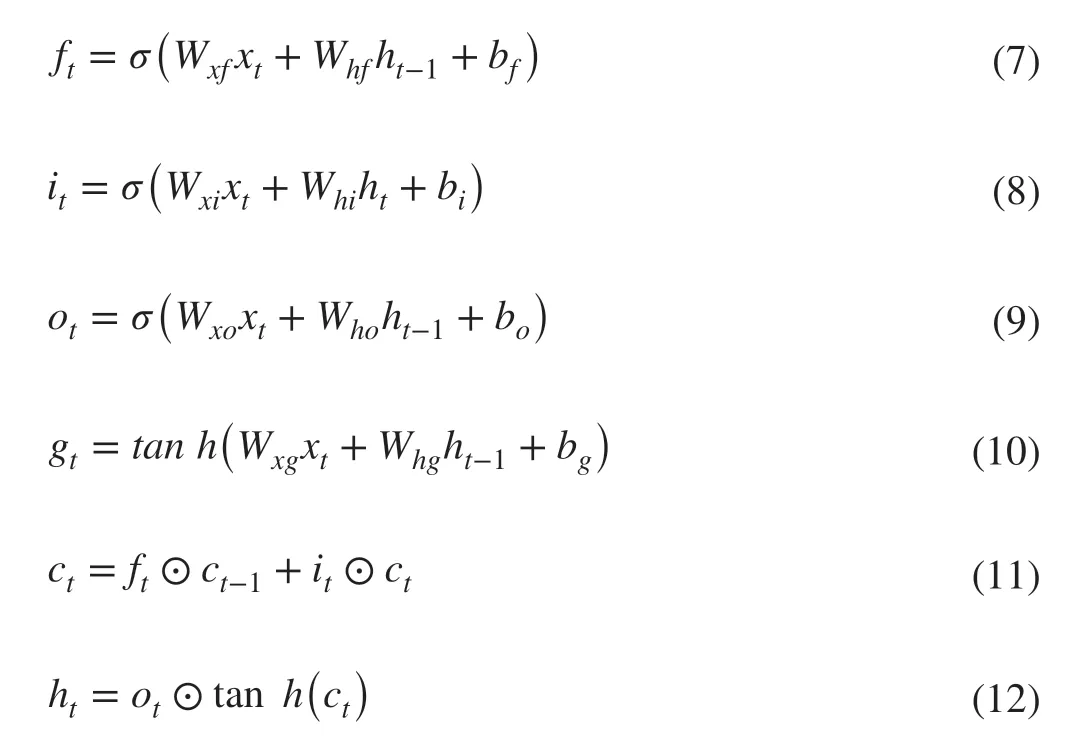
wheretis the time step,Xtis the input vector, Ct-1is the memory from the previous block, ht-1is the output of the previous block, Ctand htare respectively the memory and output of the current block,σis the sigmoid, tanh is the hyperbolic tangent, ʘ is the Hadamard operator,Wis each layer’s assigned weight,xtis the input time stept,bis the bias for each gate. In Figure 2,Xtis the input vector, Ct-1is the memory from the previous block, ht-1is the output of the previous block, Ctandhtare respectively the memory and output of the current block,σis the sigmoid,tanh is the hyperbolic tangent, 0 is the bias, × and+are the element-wise multiplication and summation/concatenation,respectively.
2.2.3 Performance Indicators
To quantitatively evaluate the LSTM forecast performance,four commonly used statistical techniques are applied. The root mean square error (RMSE), relative RMSE (RRMSE),mean absolute error (MAE), and correlation coefficient (r2)are given as follows:
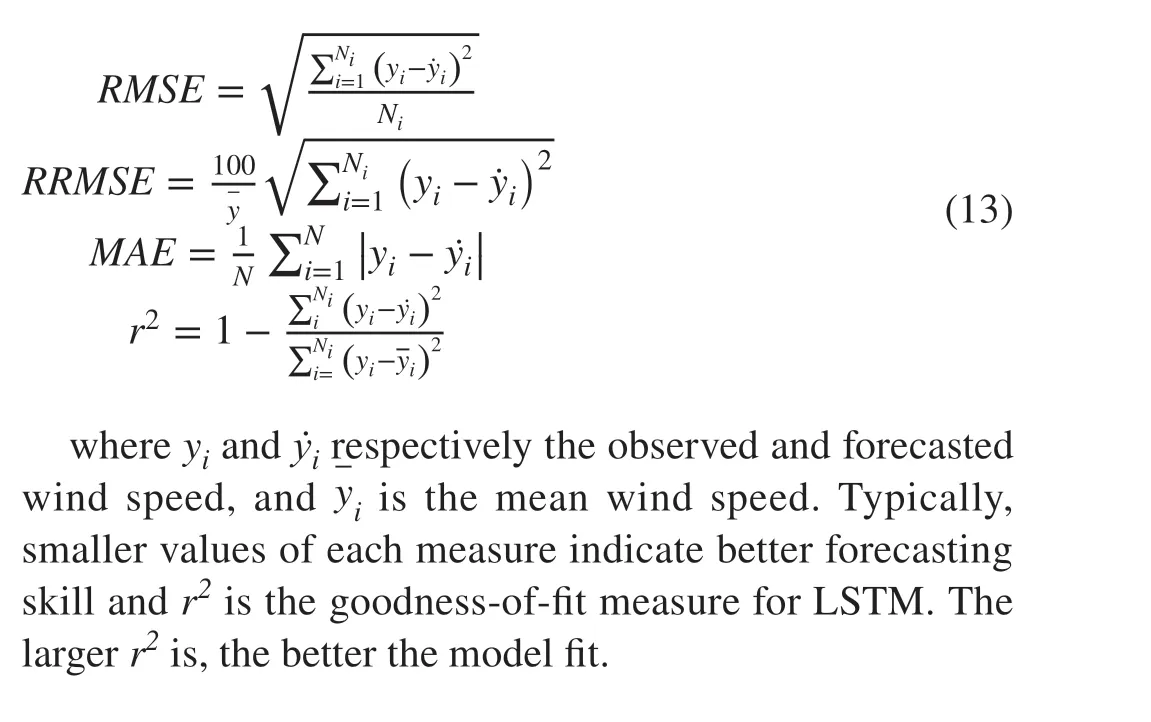
3 Results
3.1 Scatterometer Results
Employing daily scatterometer observations of surface wind speed, it can be observed in the 2009-2019, 11-year means plotted in Figure 3a that wind speeds indeed exceed 10 m/s throughout the majority of the CS, peaking at approximately 15 m/s along the Caribbean Colombian coastline.When these wind speeds are processed into wind energy density in Figure 3b, minute spatial deviations in wind speed throughout the region become more pronounced due to the cubed relationship between wind speed and energy density (Eq. 2). The wind power density (WPD) over the study period reached an 11-year maximum mean of 1000 W/m2, though this value is observed only along the Colombian Caribbean coastline. In the central Caribbean, WPD decreased radially from that point to 480-800 W/m2in the eastern and western Caribbean Sea, before reaching a minimum of approximately 200 W/m2in the Colombian Basin,Gulf of Honduras, Gulf of Gonâve, and along the northern Venezuelan coastline. The Lesser Antilles in the eastern Caribbean Sea also feature relatively a relatively high wind power density of 400-600 W/m2.
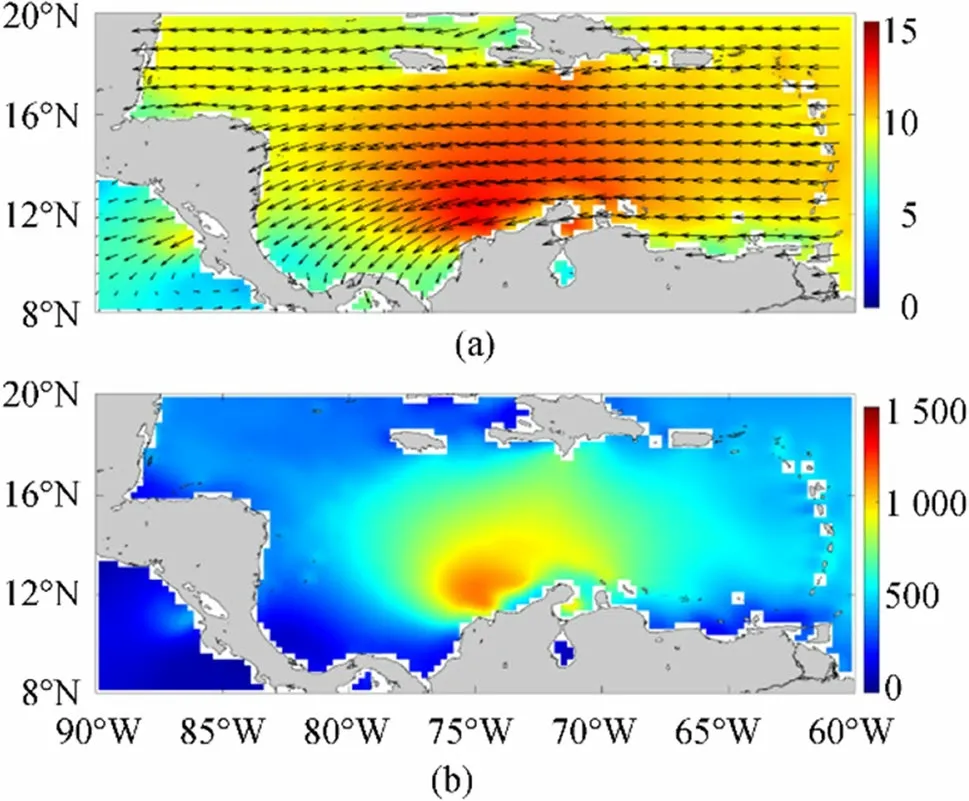
Figure 3 Eleven-year (2009-2019) mean wind speed (a) and wind power density (b) derived from scatterometer observations converted the 100 m height
On a monthly scale, plotted in Figure 4, it can be observed that the highest wind speeds, i.e., those exceeding 8 m/s, and over the widest surface area are found over 8 months ranging from January to April and July, August, October, and November. This pattern, and the general pattern of surface wind speed, is caused by the presence and activity of the CLLJ, which is the one of the main regional climatic features (Whyte et al., 2008; Durán-Quesada, et al., 2020). For the remaining months, mean wind speeds dip below 8 m/s,and its area of effect is significantly reduced as compared to the more active months. June, in particular, has very low wind speeds and only the eastern CS has wind speeds ranging from 6-7 m/s, though this pattern is eliminated during July. Additionally, and most relevant for this study, while the highest wind speeds are observed in the Colombian CS,the largest area of intense winds are in the central Caribbean Sea, far offshore. It should also be noted that under direct CLLJ forcing, the highest mean wave heights and winds(inclusive of extremes) would also be found in this area(Appendini et al., 2014, 2015: Devis-Morales et al., 2017),thus encumbering offshore operations.
Using Eq. 2, wind speeds converted to the 100 m height were processed into WPD, with results plotted in Figure 5.There, it can be observed that maximum WPD occurs temporally in January, July, and October and can reach approximately 1500 W/m2, though the spatial distribution of these values is constricted to a very small area just off the Colombian CS. A WPD of 750 W/m2is observed in the central CS that lasts from January-May, July, August, October, and November, a 9-month period. At this juncture, it is worth noting that results observed from scatterometer measurements are in strong agreement with those as derived from reanalysis (Chadee and Clarke, 2014; Soares et al., 2020),thereby demonstrating the interchangeability of datasets for wind energy resource assessments.
To investigate the stability of wind energy, nondimensional monthly and seasonal coefficients of variation were computed (Eqs. 3 and 4, respectively) with the results plotted in Figure 6. On monthly scales (Figure 6a), it is easily observed that WPD in the southern Colombian Basin in the Mosquito and Darien Gulfs is very unstable, though stability increases gradually towards the north and reaches comparable levels of stability as compared to the Venezuelan Basin at the 16°N line of latitude. Similar patterns can be observed on seasonal scales (Figure 6b), though to a significantly reduced degree. Consequently, in terms of resource availability (Figure 3) and stability, the central CS is suggested to be the optimum location for offshore wind turbine installations. To confirm this hypothesis, buoys located throughout the CS are accessed and their data used in the subsequent section to calculate wind turbine electricity output.
3.2 Buoy Results
Using the available records, wind roses were plotted for each of the NDBC buoys and are displayed in Figure 7. The most prominent feature is that regardless of buoy, winds primarily blow from the east, though more directional spread can be observed at buoy 42,057 (Figure 7a), than any other.Additionally, wind speed in no case was observed to exceed 14 m/s, but this is naturally deceptive as it is relatively unlikely for hurricanes that enter the region to pass close enough to any buoy to have its data recorded without instrumentation damage. Consequently, and based on this observation, in the future selection of offshore wind turbines, class 1 turbines should be chosen as these are designed to endure the tough operating conditions experienced at sites with average wind speeds above 8.5 m/s. Turbine selection should also consider hurricane activity.
To estimate candidate site suitability, Eq. 4 is used to compute the theoretical energy output for the Swiss Electric YZ150/10.2 turbine based on the wind power curves which,in Figure 8, graphically display the relationship between the rated wind turbine hub height and wind speed (Lydia et al.,2014; 2015). In each case, it can be observed that wind speeds observed by the buoys exceeded the cut-out speed of the turbine, necessitating a shutdown. This can be attributed easily to either hurricane or in the case of buoy 42,058 that lies in the central CS, strong CLLJ activity.
Using the power curves of Figure 5, the theoretical average turbine power for each buoy location is given inTable 4, unsurprisingly, buoy 42,058, with 8.2 MW electricity output approached closest to the turbine’s maximum of 10 MW, followed by 42,059 at 6.5 MW, 42,060 at 6 MW,and 42,057 at 5.6 MW, thus illustrating that with increasing distance away from the central CS and CLLJ, energy output correspondingly decreases. Consequently, purely in terms of electrical output potential, placing turbines further offshore would be ideal. However, additional considerations such as anchoring and mooring design which are dependent on water depth, seabed characteristics and environmentalimpact complicate the identification of optimal installation sites (Jiang, 2021).
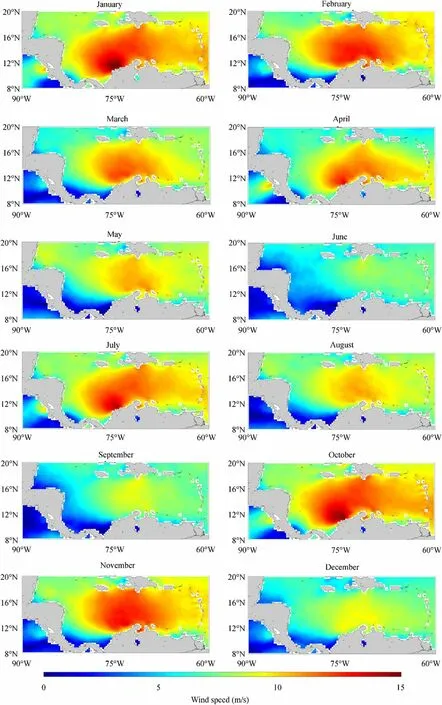
Figure 4 Mean monthly scatterometer-derived surface wind speeds over the 11-year,2009-2019 period

Figure 5 Mean monthly scatterometer-derived surface wind power density over the 11-year, 2009-2019 period
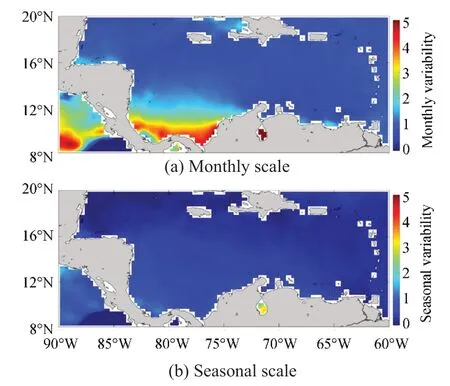
Figure 6 Coefficient of variation. a Monthly scale. b Seasonal scale
With reference to the water depths of each buoy listed in Table 2, it can be suggested that neither gravity base foundation, monopile, nor jacket-supported bottom-fixed offshore wind turbines would be suitable as they are considered economic for water depths of less than 10 m, 20-40 m, and 50-70 m, respectively (Dong et al., 2011; Hermans and Peeringa, 2016; Wu et al., 2019). Consequently, floating wind turbines are perhaps the best choice as they can access depths of up to 700-1300 m (Musial et al., 2016), but this range excludes all locations but buoy 42,057 that possesses the lowest theoretical output. It is natural to consider that offshore wind turbine installations should therefore happen within significantly shallower water. For the Caribbean Sea that is comprised of SIDS and Central and South American coastal communities, this option is perhaps not feasible as their tourist-based economies rely heavily on unspoiled natural landscapes (Maslov et al., 2017; Jensen et al., 2018;WTTC, 2019; Peterson, 2020). In addition to installing wind turbines further offshore, another strategy to increase total electrical output of a possible wind farm could be to increase the rated wind power for a given turbine so more electricity can be produced at a given site. Generally, while these and past results have argued for the development of larger and taller wind turbines to harness more energy in the same geographical space, thereby increasing overall efficiency, it can be equivalently suggested that developing small but powerful and efficient (i.e., high power ratings) turbines would achieve similar results. Research into the optimization of wind turbine hub heights is thus essential for a given region(IEC, 2005; Sieros et al., 2012; Lee et al., 2019).
Forecasting of energy resources is crucial for optimum grid control and design in power plants, power allocation, in addition to economic scheduling, dispatching, among other operations (Nazir et al., 2020; Santhosh, et al., 2020). In this section, the forecasting of wind speed is performed using the LSTM neural network to demonstrate applicability on regional NDBC buoy observations. For each buoy case, 70%of the data was used to train the model, with the remaining 30% forecasted. In each buoy case, preliminary experimentsshowed that a time step of 3 h was optimum and was used to conduct hour-ahead forecasting. As shown in Figure 9 with results listed in Table 5, regardless of buoy location,LSTM forecasting accuracy exceeds 0.90, demonstrating its strong ability to forecast surface wind speed. With reference to Figure 1, it can also be observed that central CS buoys(42,058 and 42,059) had the highestr2and lowest RMSE,RRMSE, and MAE values, with border CS buoys (42,057 and 42,060) having comparatively lower forecast skill. As the main axis of the CLLJ lies at the 15°N, central CS buoys recorded winds direct from the jet, while border CS buoys recorded the weak winds at either the head of the CLLJ(buoy 42,060), or its tail (buoy 42,057), rather than its body(buoys 42,058 and 42,059).
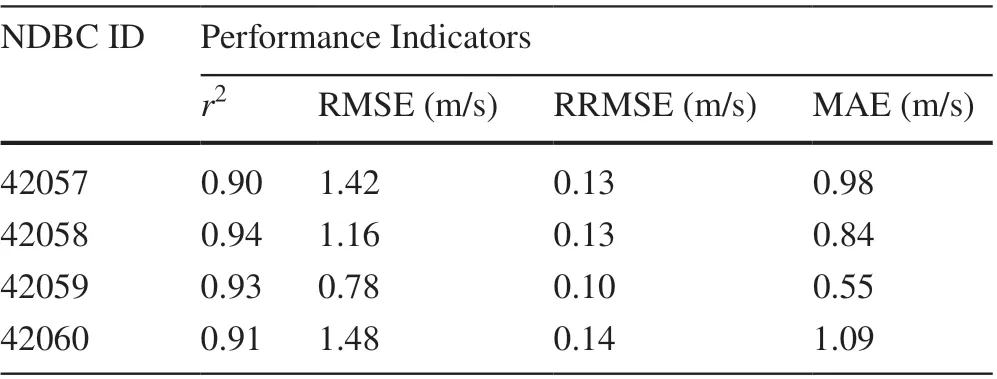
Table 5 Three-hour 100-m wind speed forecast results

Figure 9 a-d Forecast (3 h) of buoy-observed wind speed extrapolated to the 100-m height results. Data points refer to the number of wind speed observations
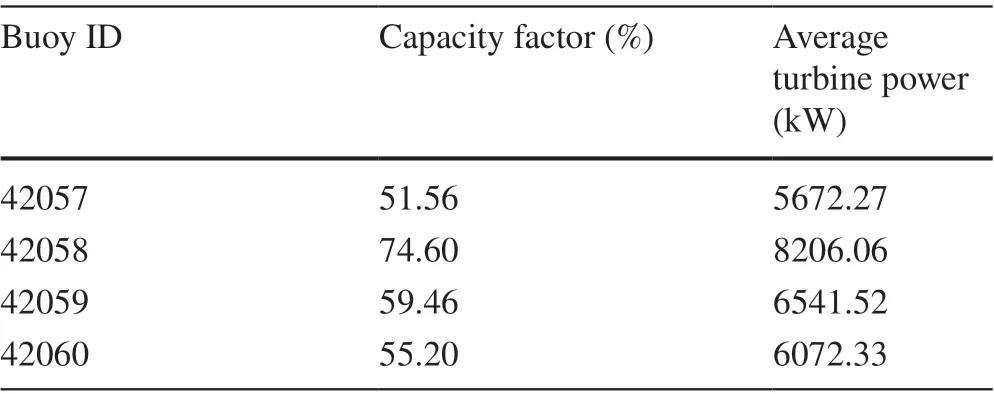
Table 4 Capacity factor and average power at each NDBC buoy location at the 100-m hub height for the Swiss Electric YZ150/10.2 off-shore wind turbine

Figure 7 a-d Wind roses for National Data Buoy Center buoys. Wind speed is given in m/s and was discretized into 8 equally spaced, 45° wide bins
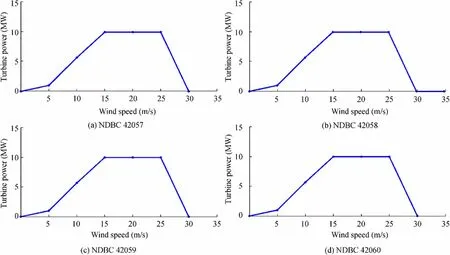
Figure 8 a-d Swiss Electric YZ150/10.2 turbine power curves for NDBC buoys
Though this preliminary study restricted the forecast lag to 3 h, both increasing and decreasing the forecast horizon are the subjects of intensive study for short-term (inclusive of the ultra-short-term) and long-term predictions (Lu et al.,2018; He and Xu, 2019; Akhtar et al., 2021) and as such,future studies should include additional variables such as air temperature and pressure that would make such forecasts feasible. Different forecast horizons are required for different applications, and thus, this research is of primary importance for a nascent offshore wind energy industry in the CS and should be conducted in subsequent research.
4 Conclusion and Discussion
Global island and coastal communities are inextricably linked to the sea and for the small island developing states(SIDS) bordering the Caribbean Sea (CS), their economic health is especially coupled. At the precipice of the UN Decade of Ocean Science for Sustainable Development(2021-2030) and under the continued context of the global transition to renewables, conducting natural resource assessments is crucial. Based on analyses of both in situ and satellite-observed surface wind speed, it was determined that purely in terms of resource availability, the central CS was the optimum location, and this is due primarily to Caribbean Low-Level Jet (CLLJ) activity that delivered intense winds exceeding 8 m/s for 7 months of the year, and over a wide geographical area. This resulted in the observation that in a very narrow area off the Colombian CS coast, mean wind power density (WPD) values peaked at 1000 W/m2at the 100 m height. In January, July, and October, it was observed that WPD could increase even further to 1500 W/m2. For the majority of the CS, although the CLLJ does vary on both spatial and temporal scales, as determined by the coefficient of variation, WPD was also very stable, thus increasing its attractiveness to energy exploitation. Wind speed forecasting is also crucial to this energy exploitation and through application of the LSTM neural network, it was found that wind speed was best predicted in the central CS under the direct influence of the CLLJ as represented by buoy 42,058.This was assessed using four common performance indicators: the correlation coefficient (r2), root mean square error (RMSE), relative root mean square error (RRMSE),and mean absolute error (MAE). Specifically, buoy 42,058 reached a maximumr2of 0.94 with a RMSE of 1.14, a RRMSE of 0.13, and a MAE of 0.84. Further away from the CLLJ’s main area of effect, buoy 42,059 had a lower forecasting accuracy withr2, RMSE, RRMSE, and MAE being measured at 0.93, 1.16, 0.13, and 0.84, respectively.The lowest forecasting skill was observed at buoy 42,057 that lies furthest away from the CLLJ main axis at the CS western border and possessedr2, RMSE, RRMSE, and MAE values of 0.90, 1.42, 0.13, and 0.98, respectively. Similarly,forecast accuracy for buoy 42,060 on the CS eastern boundary was low withr2, RMSE, RRMSE, and MAE values being measured at 0.91, 1.48, 0.14, and 1.09, respectively.In subsequent studies, higher resolution data (e.g., 10 min,rather than hourly) can be used to develop and optimize a LSTM-based ultra-short-term wind speed forecasting model.Identically, to lengthen the forecast range, additional variables such as air temperature and pressure can be included in the model for greater robustness for extended forecasts.
This study limited its investigation to the theoretical and technical wind resource potentials leaving a great deal of additional research to be conducted. Based on these preliminary results, however, it is strongly thought that offshore wind energy resources are sufficient that could, if turbines are arranged in wind farms and issues concerning their mooring/anchoring in deep water, and electricity transmissions can be mitigated, if not eliminated through technological advancements or clever strategy. For example, the issue of transmission can be dealt with, if only partially,but offshore wind farms producing energy carriers such as hydrogen and this is transported to the mainland during operation and maintenance activities. This hydrogen can also be supplied to a new generation of hydrogen-powered shipping vessels in the maritime industry. Additionally, multipurpose platforms, such as those that co-locate wind and wave energy projects or merge offshore wind and a mariculture facility could be built. This allows the disadvantages of placing such facilities so far offshore to be offset. Extreme waves and hurricane activity remain considerable hurdles to wind energy development in the CS and should be intensely studied in future research if the project is to be made not only economically viable, but one that SIDS and coastal communities Scan rely on for reducing carbon dioxide emissions, triggering economic growth, and providing employment opportunities.
AcknowledgementsThe author thanks Ali Sichone for his assistance in using the LSTM network and visualization.
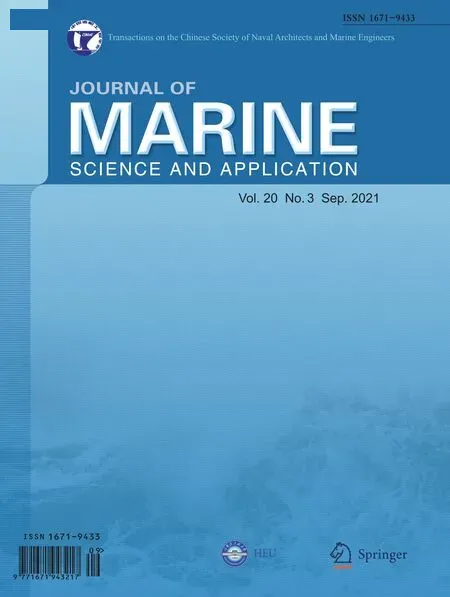 Journal of Marine Science and Application2021年3期
Journal of Marine Science and Application2021年3期
- Journal of Marine Science and Application的其它文章
- A Port Ship Flow Prediction Model Based on the Automatic Identification System and Gated Recurrent Units
- Sinusoidal Vertical Motion Suppression and Flow Noise Calculation for a Sonobuoy
- Validation of an Emission Model for a Marine Diesel Engine with Data from Sea Operations
- A Case Study of a Solid Oxide Fuel Cell Plant on Board a Cruise Ship
- Experimental Study of a Modified Command Governor Adaptive Controller for Depth Control of an Unmanned Underwater Vehicle
- Multi-Crack Interaction and Influence on the Spherical Pressure Hull for a Deep-Sea Manned Submersible
